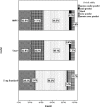Validation and comparison between two warfarin dosing clinical algorithms and warfarin fixed dosing in specialized heart center: cross-sectional study
- PMID: 36733524
- PMCID: PMC9851814
- DOI: 10.18549/PharmPract.2022.3.2722
Validation and comparison between two warfarin dosing clinical algorithms and warfarin fixed dosing in specialized heart center: cross-sectional study
Abstract
Background: Warfarin is well known as a narrow therapeutic index that has prodigious variability in response which challenges dosing adjustment for the maintenance of therapeutic international normalized ratio. However, an appreciated population not on new oral anticoagulants may still need to be stabilized with warfarin dosing.
Objective: The current study's main objective was to validate and compare two models of warfarin clinical algorithm models namely the Gage and the International Warfarin Pharmacogenetics Consortium (IWPC) with warfarin 5 mg fixed standard dosing strategy in a sample of Sudanese subjects.
Method: We have conducted a cross-sectional study recruited from the out-patient clinic at a tertiary specialized heart center. We included subjects with unchanged warfarin dose (stabilized), and with therapeutic international normalized ratio. The predicted doses of warfarin in the two models were calculated by three different methods (accuracy, clinical practicality, and the clinical safety of the clinical algorithms).
Main outcome measure: The primary outcomes were the measurements of the clinical (accuracy, practicality, and safety) in each of the two clinical algorithms models compared to warfarin 5 mg fixed standard dose strategy.
Results: We have enrolled 71 Sudanese subjects with mean age (51.7 ± 14 years), of which (49, 69.0%) were females. There was no significant difference between the warfarin 5 mg fixed standard dose strategy and the predicted doses of the two clinical algorithm models (MAE 1.44, 1.45, and 1.49 mg/day [P =0.4]) respectively. In the clinical practicality, all of the three models had a high percent of subjects (95.0%, 51.9%, and 66.7%) in the ideal dose range in middle dose group (3-7 mg/ day) for warfarin 5 mg fixed standard dosing strategy, Gage, and IWPC clinical algorithm models respectively. However, a small percent of subjects was exhibited in the warfarin low dose group ≤ 3 mg/day (0.0%, 15.0%, and 10.0%) and warfarin high dose group ≥ 7 mg/day (0.0%, 33.3%, and 33.3%) for warfarin 5 mg fixed standard dosing strategy, Gage, and IWPC clinical algorithms respectively. In terms of clinical safety, the percent of subjects with severely over-prediction were 28.2%, 22.5%, and 22.5% for warfarin 5 mg fixed standard dosing, Gage, and IWPC, respectively. While the percent of severely under-prediction was 12.7%, 7.0%, and 5.6% for the warfarin 5 mg fixed standard dosing, Gage, and IWPC, respectively.
Conclusion: The Gage and IWPC clinical algorithm models were accurate, more clinically practical, and clinically safe than warfarin 5 mg standard dosing in the study population. The cardiologist can use either models (Gage and IWPC) to stratify subjects for accurate, practical, and clinically safe warfarin dosing..
Keywords: accuracy; clinical safety; over-prediction; practicality; under-prediction; warfarin clinical algorithms; warfarin fixed standard dosing strategy.
Copyright: © Pharmacy Practice.
Figures



References
-
- 1. Roper N, Storer B, Bona R, et al. Validation and Comparison of Pharmacogenetics-Based Warfarin Dosing Algorithms for Application of Pharmacogenetic Testing. J Mol Diagn. 2010;12(3):283-291. https://doi.org/10.2353/jmoldx.2010.090110 - PMC - PubMed
- Roper N, Storer B, Bona R, et al. Validation and Comparison of Pharmacogenetics-Based Warfarin Dosing Algorithms for Application of Pharmacogenetic Testing. J Mol Diagn. 2010;12(3):283–291. doi: 10.2353/jmoldx.2010.090110. - DOI - PMC - PubMed
-
- 2. Finkelman BS, Gage BF, Johnson JA, et al. Genetic Warfarin Dosing:Tables Versus Algorithms. J Am Coll Cardiol. 2011;57(5):612-618. https://doi.org/10.1016/j.jacc.2010.08.643 - PMC - PubMed
- Finkelman BS, Gage BF, Johnson JA, et al. Genetic Warfarin Dosing:Tables Versus Algorithms. J Am Coll Cardiol. 2011;57(5):612–618. doi: 10.1016/j.jacc.2010.08.643. - DOI - PMC - PubMed
-
- 3. Kimmel SE, French B, Kasner SE, et al. A Pharmacogenetic versus a Clinical Algorithm for Warfarin Dosing. N Engl J Med. 2013;369(24):2283-93. https://doi.org/10.1056/NEJMoa1310669 - PMC - PubMed
- Kimmel SE, French B, Kasner SE, et al. A Pharmacogenetic versus a Clinical Algorithm for Warfarin Dosing. N Engl J Med. 2013;369(24):2283–93. doi: 10.1056/NEJMoa1310669. - DOI - PMC - PubMed
-
- 4. Hamberg A-K, Hellman J, Dahlberg J, et al. A Bayesian decision support tool for efficient dose individualization of warfarin in adults and children. BMC Med Inform Decis Mak. 2015;15:7. https://doi.org/10.1186/s12911-014-0128-0 - PMC - PubMed
- Hamberg A-K, Hellman J, Dahlberg J, et al. A Bayesian decision support tool for efficient dose individualization of warfarin in adults and children. BMC Med Inform Decis Mak. 2015;15:7. doi: 10.1186/s12911-014-0128-0. - DOI - PMC - PubMed
-
- 5. Cho S, Lee K, Choi JR, et al. Development and Comparison of Warfarin Dosing Algorithms in Stroke Patients. Yonsei Med J. 2016;57(3):635-640. https://doi.org/10.1056/NEJMoa1310669 - PMC - PubMed
- Cho S, Lee K, Choi JR, et al. Development and Comparison of Warfarin Dosing Algorithms in Stroke Patients. Yonsei Med J. 2016;57(3):635–640. doi: 10.1056/NEJMoa1310669. - DOI - PMC - PubMed
LinkOut - more resources
Full Text Sources
